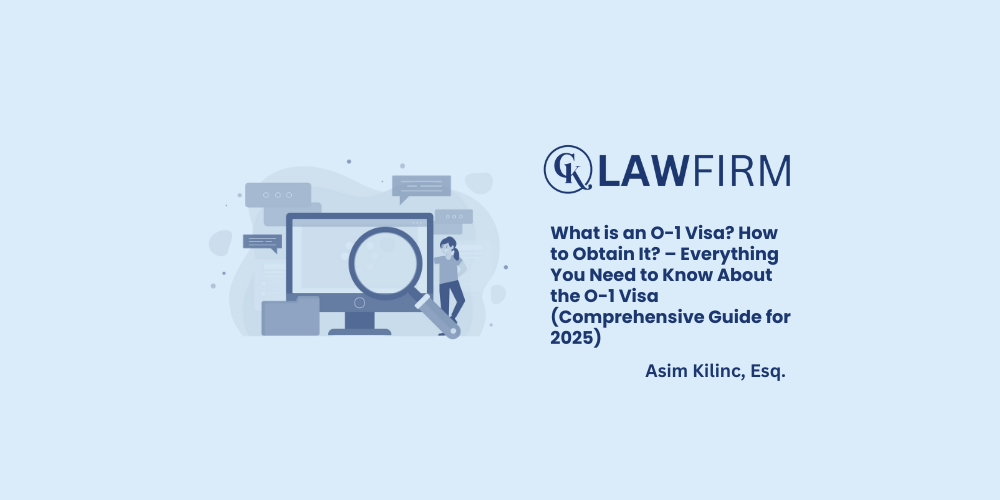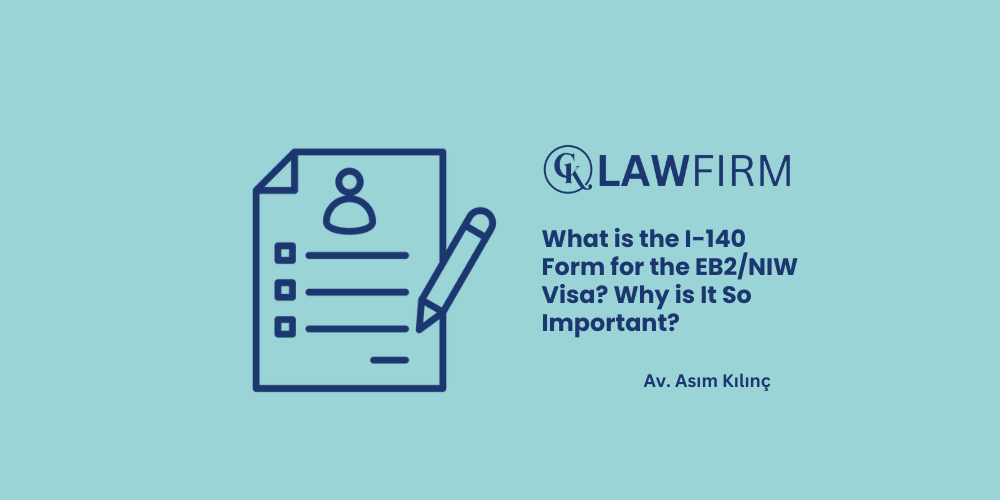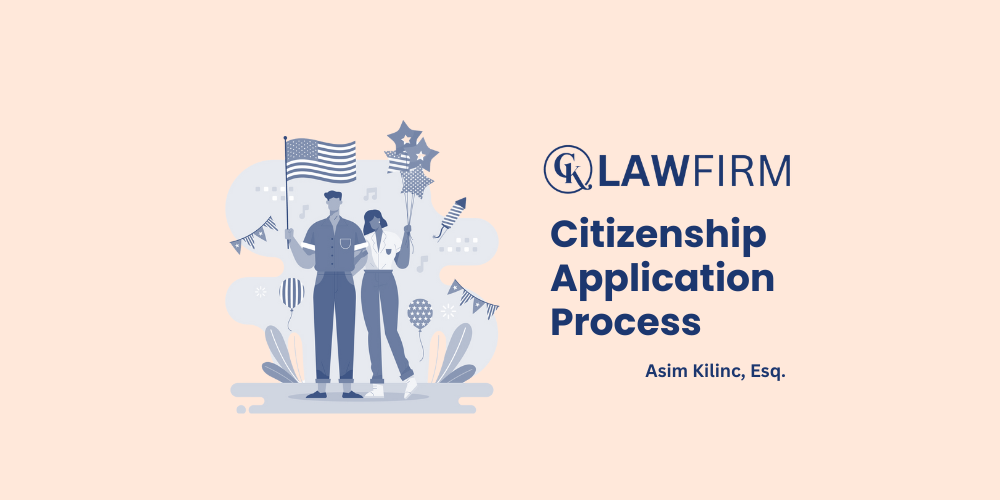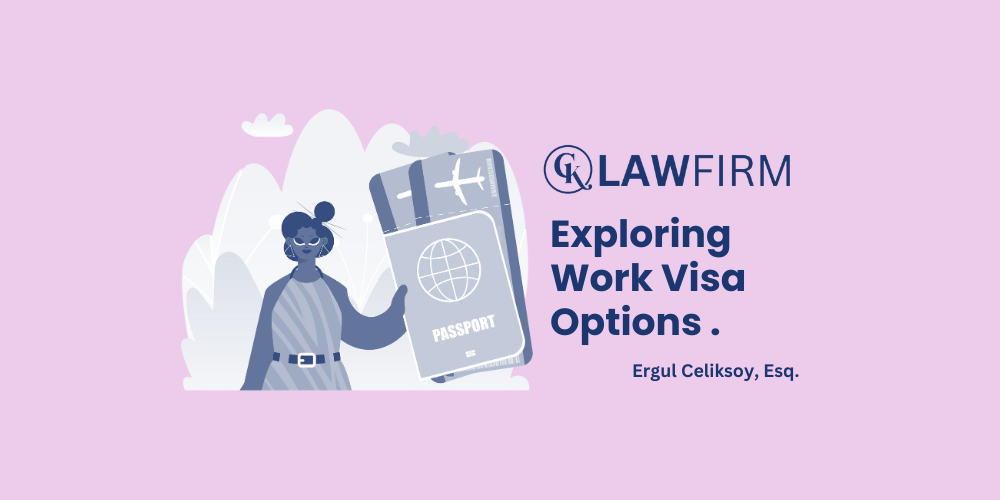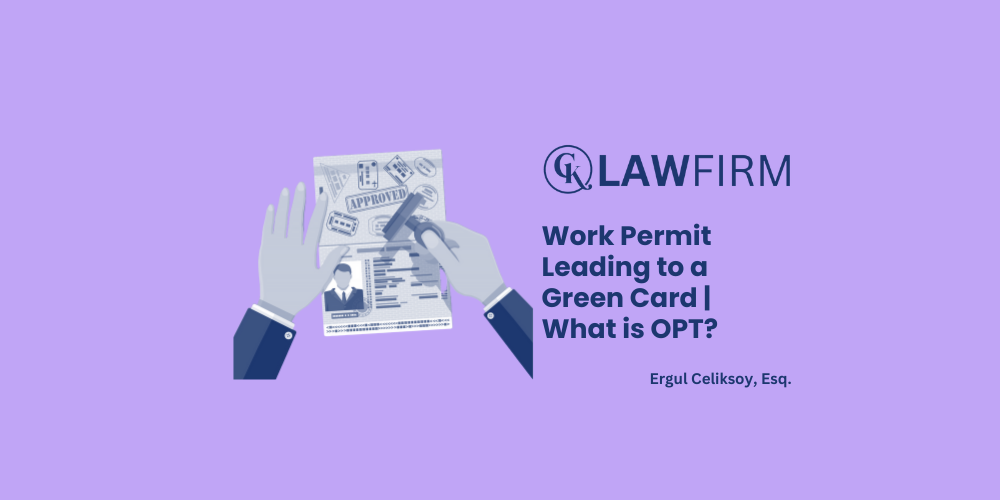Schedule an Appointment with Our Attorneys Now
Asım Kılınç, Immigration Attorney, CK Law Firm
The O-1 visa is a special work visa granted to individuals with extraordinary abilities in the United States. With this visa, Turkish citizens also gain access to a prestigious opportunity. It allows individuals who have demonstrated exceptional achievements in fields such as the arts, sciences, business, education, or sports to work and reside temporarily in the U.S. In this article, I delve into the details of the O-1 visa and address the following topics:
- What is the O-1 Visa? What Are Its Requirements?
- How to Obtain an O-1 Visa for the U.S.? What Are Its Advantages?
- Who Can Apply for the O-1 Visa? Who Is It Suitable For?
- How to Apply for the O-1 Visa? – Information About the Process
- What Documents Are Required for the O-1 Visa?
- How Long Is the O-1 Visa Valid? What Is Its Duration of Validity?
- Are There Quotas for O-1 Visas?
If you have any additional questions about the O-1 visa, please don’t hesitate to reach out through the comments section below this article or via the CK Law Firm Immigration Attorney Firm’s Website. You can also contact me directly on LinkedIn for any inquiries you may have!
What is an O-1 Visa? What Are Its Requirements?
Why Is the O-1 Visa Suitable for Entrepreneurs and Startups?
This visa is a work visa designed for individuals with extraordinary abilities in fields such as science, business, education, or athletics. Unlike many other U.S. work visas, the O-1A visa allows you to sponsor yourself by establishing your own company instead of relying on a U.S. employer. This flexibility provides a significant advantage for startup founders and entrepreneurs.
Advantages of the O-1 Visa for Entrepreneurs
- Unlimited Renewals: The O-1A visa has no annual cap, allowing for flexible renewals.
- Broad Eligibility: Covers a wide range of fields, from science to business.
- No Formal Education Requirement: Focuses on achievements and skills rather than formal education.
- Family Coverage: Spouses and children can live in the U.S. under an O-3 visa.
- Fast Processing: Premium processing allows decisions within 15 days.
- No Salary Requirements: You can set your own salary as the founder of your company.
How to Obtain an O-1 Visa
1. Gather the Required Evidence
To demonstrate your extraordinary abilities, prepare the following:
- Awards or notable achievements
- Memberships in professional associations
- Media coverage
- Roles as a judge or evaluator in your field
- Patents or original contributions
2. Establish Your U.S. Company (Self-Sponsor)
By setting up your own company, you can present yourself as the “employer.” This step is crucial for creating an employer-employee relationship.
3. Sign an Employment Contract with Yourself
Draft an employment contract with your U.S. company for a leadership or equivalent role.
4. File Form I-129 with USCIS
Complete Form I-129 on the U.S. Citizenship and Immigration Services (USCIS) website and submit it.
5. Attend the Visa Interview
Once your visa is approved, you’ll be invited for an interview at the nearest U.S. consulate. During the interview, present your documents and achievements professionally and confidently.
The O-1A visa provides a unique opportunity for entrepreneurs aiming to establish businesses in the U.S. However, preparing the necessary documents, completing company setup, and developing a solid application strategy are critical to a successful application. Seeking expert assistance can simplify the process and help you achieve your goals quickly.

Differences Between the O-1A and O-1B Visas
The O-1 visa is divided into two categories:
- O-1A Visa: Designed for individuals with extraordinary abilities in science, business, education, or athletics.
- O-1B Visa: Tailored for individuals who have demonstrated extraordinary achievements in the arts, film, or television industries.
While the O-1A visa covers a broader range of fields, the O-1B visa focuses specifically on creative and artistic endeavors. For instance:
- A startup founder or scientist would apply for the O-1A visa.
- A film director or actor would apply for the O-1B visa.
Additionally, the O-1B visa is often tied to specific projects in the arts and entertainment industries, whereas the O-1A visa offers greater flexibility across various fields.
How Long Is the O-1 Visa Valid?
The duration of the O-1 visa depends on the length of the project or employment contract mentioned in your application. Generally, the O-1 visa is valid for up to 3 years.
With valid justification, you can apply to extend this visa, allowing you to remain in the U.S. without transitioning to another visa type. For more detailed information on validity periods, feel free to reach out to me directly on LinkedIn.
Is There a Cap on O-1 Visas?
Unlike many other visa types, the O-1 visa does not have an annual cap. However, applications are meticulously reviewed, so it’s essential to submit a flawless application to improve your chances of approval.
Proper guidance is crucial for a successful O-1 visa application. If you’re considering applying for an O-1 visa, you can contact me through the comments section below this article, send me a message directly on Linkedln, or visit the website of CK Law Firm, where I am a co-founder, for assistance on various topics.

Asım Kılınç, Immigration Attorney, CK Law Firm
The EB2/NIW (Employment-Based Second Preference National Interest Waiver) visa is a significant opportunity for highly educated professionals and individuals specializing in certain fields who wish to work and obtain permanent residency in the United States. This visa allows individuals who can contribute to the national interest of the U.S. to apply without the need for an employer sponsorship. It serves as a key immigration pathway for professionals in science, technology, engineering, mathematics (STEM), business, healthcare, and other critical industries.
One of the most critical steps in this process is the I-140 Form. The EB2/NIW visa I-140 form is an official petition submitted to the U.S. Citizenship and Immigration Services (USCIS) that details the applicant’s qualifications, professional achievements, and potential contributions to the U.S.. USCIS evaluates whether the applicant meets the NIW criteria through this form and determines whether to advance the application to the next stage. In this guide, we will cover:
- What is the I-140 Form?
- Why is the I-140 Form Important?
- I-140 Form & NIW Criteria: Strengthening Your Application
- How to Prepare Strong Recommendation Letters for I-140?
- Common Mistakes in the I-140 Form and How to Avoid Them
- Next Steps After EB2/NIW Visa and I-140 Approval
- What to Do If Your I-140 Form is Denied?
If you have any additional questions or require personalized assistance, feel free to contact us through our website or reach out to me directly via LinkedIn. Enjoy your reading!
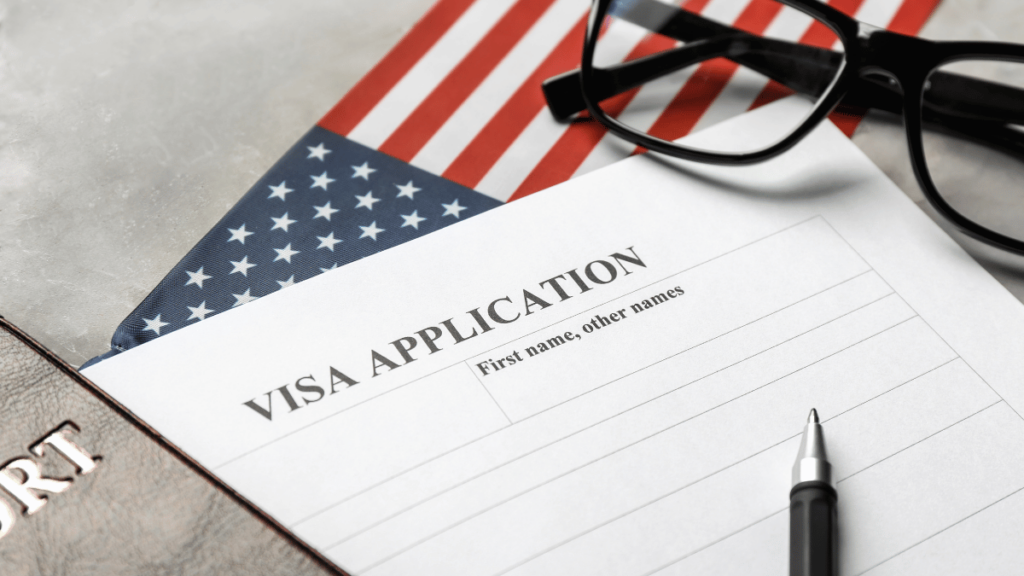
What is the I-140 Form?
The I-140 Form is a critical petition submitted to USCIS by either an employer or an individual applicant as part of the EB2/NIW green card application process. This form serves as proof that the applicant has the necessary qualifications to work in the United States and can contribute positively to the country.
The Primary Purpose of the I-140 Form
- To verify the applicant’s professional qualifications and expertise
- To allow applications without employer sponsorship under the National Interest Waiver (NIW)
- To identify individuals who can contribute to the U.S. economy or society
Why is the I-140 Form So Important?
The EB2/NIW visa I-140 form is a crucial step in the immigration process for several reasons:
- It Establishes Eligibility: USCIS determines whether the applicant qualifies for the EB2/NIW visa based on the information in the I-140 form.
- It Opens the Green Card Pathway: Approved applicants can proceed with the I-485 (Adjustment of Status) application to obtain permanent residency.
- It Provides Independence from Employers: Since EB2/NIW applications do not require employer sponsorship, applicants can apply on their own.
- It Can Be Expedited: The premium processing option can speed up the application process.
- It Increases Work & Residency Opportunities: A successful I-140 approval enhances long-term stay and career prospects in the U.S.
EB2/NIW Visa I-140 Form & NIW Criteria: Strengthening Your Application
To successfully complete the EB2/NIW visa application, you must satisfy the Dhanasar criteria when filling out the I-140 form. These three key requirements include
- Your work must be of substantial importance to the U.S.
- The U.S. must have an urgent need for your expertise.
- Your work in the U.S. must provide a significant national benefit.
By presenting strong evidence for these criteria, you can significantly enhance your chances of I-140 approval.
How to Prepare Strong Recommendation Letters for I-140?
Well-crafted recommendation letters play a vital role in increasing your chances of approval. Here are some tips for preparing effective letters:
- Obtain letters from recognized experts in your field (professors, executives, industry leaders, researchers).
- Include specific details about your projects, achievements, and contributions.
- Highlight how your work benefits the national interest of the U.S.
Example Structure of a Recommendation Letter:
- Applicant’s area of expertise
- Applicant’s achievements, research, and contributions
- How the applicant’s work benefits the U.S.
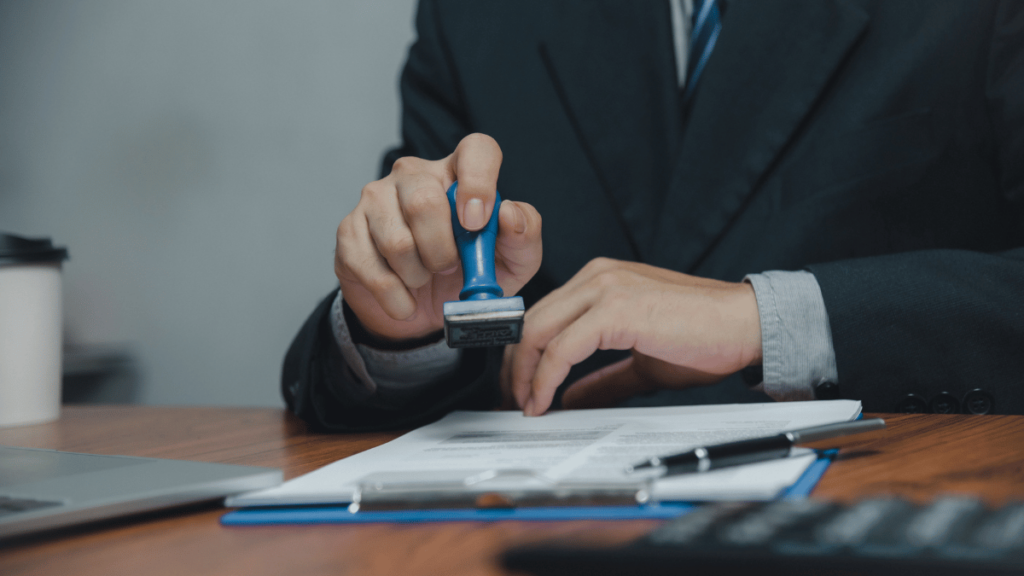
Common Mistakes in the I-140 Form and How to Avoid Them
Errors in the I-140 application can lead to rejections. Here are the most frequent mistakes and how to avoid them:
Submitting Incomplete or Incorrect Documents
- Ensure all identity and professional documents are complete and consistent with the application.
Providing Inconsistent Information
- Ensure that all information is accurate and matches throughout the application.
Failing to Provide Sufficient Evidence
- Submit proof of work experience, academic success, publications, projects, and contributions to the U.S. economy or society.
Next Steps After EB2/NIW Visa & I-140 Approval
Once your I-140 is approved, you can move forward with the green card application process. The following steps apply:
| Step | Description |
|---|---|
| I-485 Application | If you are in the U.S., you can apply for Adjustment of Status. |
| Consular Processing | If you are outside the U.S., you will attend a visa interview at a U.S. consulate. |
| Work & Residency Planning | Organize your employment and residency permits in the U.S. |
What to Do If Your EB2/NIW Visa I-140 Form is Denied?
If your I-140 form is denied, don’t panic! Here’s what you should do:
📌 Review the Denial Reason
- Carefully read the denial letter from USCIS to identify mistakes or missing documents.
📌 Consider Filing an Appeal
- You may submit a MOTION TO REOPEN or MOTION TO RECONSIDER to challenge the decision.
- If necessary, correct any errors and resubmit your application.
📌 Explore Alternative Visa Options
- Consider applying for other visa categories such as EB1 or O1, if eligible.
- Consult with an immigration attorney for guidance.
If you are considering applying for an EB2/NIW visa and submitting an I-140 form, this guide provides essential insights into the process. Successfully navigating this pathway requires a well-planned strategy and professional preparation.
At CK Law Firm, we are here to guide you through every step of your journey. For more information, feel free to contact us via our official website. If you have any questions, you can also reach out to me directly on LinkedIn.
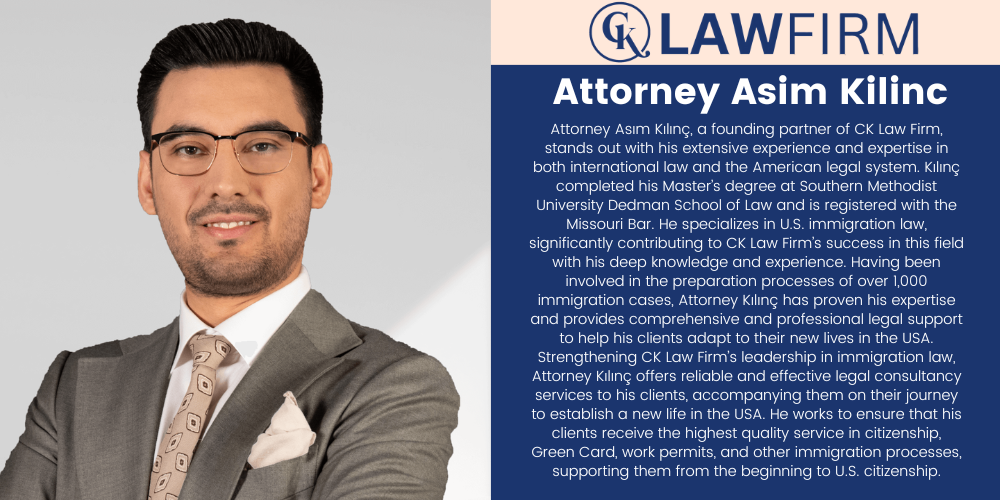
By Ergul Celiksoy, Immigration Attorney at CK Law Firm
The EB2/NIW (Employment-Based Second Preference / National Interest Waiver) visa offers a significant opportunity for professionals seeking permanent residency in the United States. Unlike other employment-based visas, this immigrant visa does not require employer sponsorship, making it particularly advantageous for individuals in fields such as science, engineering, technology, and entrepreneurship. In our EB2/NIW Green Card application guide, we cover the following topics:
- What is the EB2/NIW Visa?
- What is the Difference Between the EB2/NIW Visa and the Standard EB-2 Visa?
- Who Can Apply for the EB2/NIW Visa?
- EB2/NIW Green Card Application Process
- EB2/NIW Visa Costs and Fees
- Factors that Increase the Likelihood of EB2/NIW Visa Approval
- What to Do if Your EB2/NIW Application is Denied?
We complete our EB2/NIW visa application guide with these topics. However, if you have any questions related to the E2 visa, feel free to visit our website. Also if you’d like to contact me directly, you can reach out to me through my LinkedIn account.
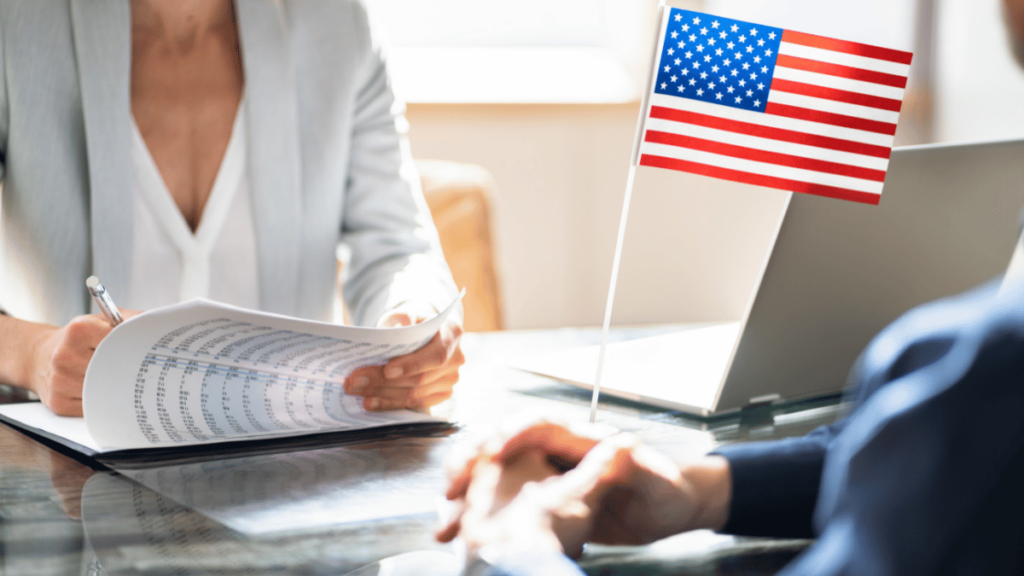
What is the EB2/NIW Visa?
The EB2/NIW (Employment-Based Second Preference / National Interest Waiver) visa is an immigrant visa designed for highly qualified individuals who can make significant contributions to the United States. Unlike the standard EB-2 visa, it allows applicants to apply without employer sponsorship.
This visa is ideal for highly educated professionals, scientists, researchers, healthcare workers, engineers, entrepreneurs, and pilots. Individuals approved for an EB2/NIW application can begin the Green Card process and obtain permanent residency in the U.S.
What is the Difference Between the EB2/NIW Visa and the Standard EB-2 Visa?
The standard EB-2 visa requires an individual to receive a job offer from an employer, with the employer supporting the immigration petition. However, the NIW (National Interest Waiver) allows applicants to waive employer sponsorship by demonstrating that their work contributes significantly to the national interest of the U.S. Below is a detailed comparison between the EB2/NIW and standard EB-2 visas:
| Criteria | Standard EB-2 Visa | EB2/NIW Visa |
|---|---|---|
| Employer Sponsorship | Required | Not Required |
| Job Offer | Required | Not Required |
| PERM Labor Certification | Required | Not Required |
| Who Can Apply? | Employer | Applicant |
| Application Process | Initiated by Employer | Applicant applies independently |
| Approval Criteria | Employer provides an appropriate position and the candidate proves qualifications | Candidate proves contribution to U.S. national interest |
| Job Change Flexibility | Employer-dependent, difficult to change | More flexible, independent from employer |
| Application Complexity | Standard and straightforward | Requires extensive proof of contributions |
| Application Time | 12-24 months | 12-24 months |
| Eligible Professions | Highly skilled professionals | Scientists, engineers, doctors, entrepreneurs, academics, etc. |
| Green Card Process Impact | Dependent on employer | Directly leads to Green Card application |
Who Can Apply for the EB2/NIW Visa?
To qualify for the EB2/NIW visa, applicants must meet at least one of the following criteria:
- Advanced Education
- A master’s degree or its equivalent, or a bachelor’s degree with at least five years of professional experience in the field.
- Extraordinary Ability
- Proven extraordinary ability in the sciences, arts, or business (e.g., academic publications, patents, awards, involvement in recognized projects, etc.).
- National Interest Contribution
- Demonstrated ability to contribute significantly to the U.S. in areas such as economic, educational, cultural, or technological development. The applicant must show that their work is in the national interest and cannot be easily replaced by U.S. workers.
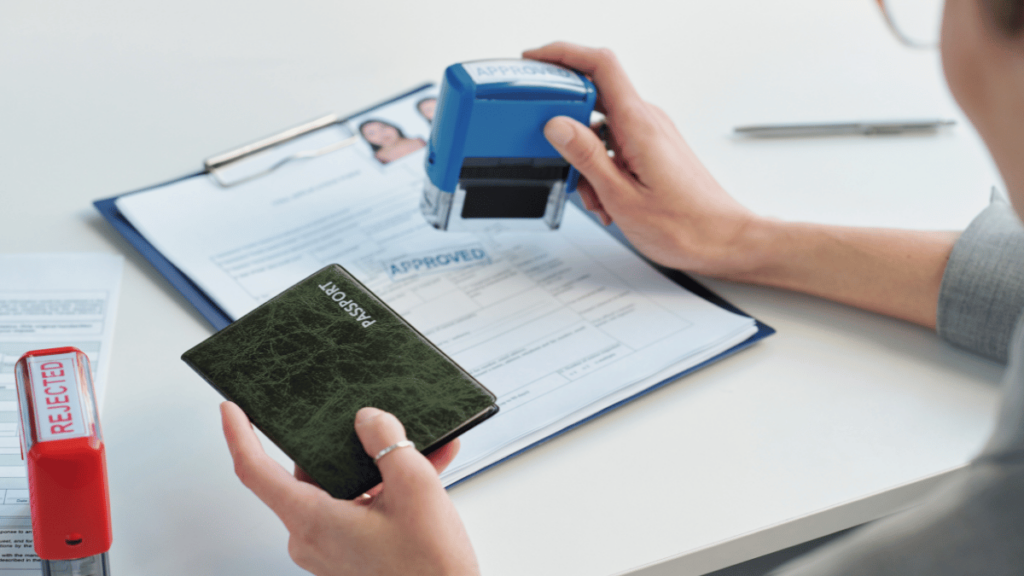
EB2/NIW Green Card Application Process
The EB2/NIW Green Card visa application process consists of three main steps:
- Step 1: Complete the I-140 Form
The application begins with the I-140 (Immigrant Petition for Alien Worker) form, which is reviewed by the U.S. Citizenship and Immigration Services (USCIS). The applicant must prove that they will contribute to the national interest of the U.S., supported by a strong application package showcasing professional achievements and expertise. - Step 2: Prepare Supporting Documents
Documents to be submitted with the I-140 form include:- Academic and professional certificates (diplomas, transcripts)
- Publications, awards, recommendation letters
- Evidence of professional achievements (patents, projects, articles)
- Details of the applicant’s contribution to U.S. economic and social development
- Documents supporting future plans
- Step 3: Green Card Application (I-485 or Consular Processing)
If the I-140 petition is approved, the applicant can proceed with the Green Card application using one of the following methods:- For those in the U.S.: File the I-485 (Adjustment of Status) form.
- For those outside the U.S.: Complete consular processing for an immigrant visa.
EB2/NIW Visa Costs and Fees
As of 2025, the estimated costs for the EB2/NIW visa application process are as follows:
| Fee Item | Cost (USD) |
|---|---|
| I-140 Petition Fee | $715 |
| I-485 (Green Card) Fee | $1,440 |
| Asylum Program Fee | $300 |
| Premium Processing Fee (Optional) | $2,850 |
Factors That Increase the Likelihood of EB2/NIW Visa Approval
To increase the chances of EB2/NIW visa approval, applicants should prepare a strong case. Key factors include:
- Industry Recognition: Demonstrating expertise through publications, awards, recommendation letters, and professional accomplishments.
- Contribution to the U.S.: Evidence of supporting economic growth, creating jobs, or fostering innovation in critical fields.
- Successful Precedents: Referring to approved cases with similar profiles.
Strong documentation and a clear plan of contribution will improve the chances of a favorable outcome.
What to Do if Your EB2/NIW Application is Denied?
If the EB2/NIW application is denied, the following actions can be taken:
- Reevaluation and Appeal: Applicants can appeal the decision or request a reevaluation of the application. Additional documents may be submitted to address any perceived shortcomings.
- Alternative Visa Options: If the EB2/NIW application is denied, other visa options like H-1B, O-1, or L-1 may be considered.
- Legal Assistance: It’s crucial to consult an immigration lawyer if your application is denied. A lawyer can help identify the reasons for the denial and guide you through the appeal process or suggest alternative visa routes.
The EB2/NIW visa is an excellent opportunity for qualified individuals seeking to live and work in the United States. However, careful management of the process is essential. If you need expert assistance, feel free to reach out through our official website. You can also contact me directly via LinkedIn.
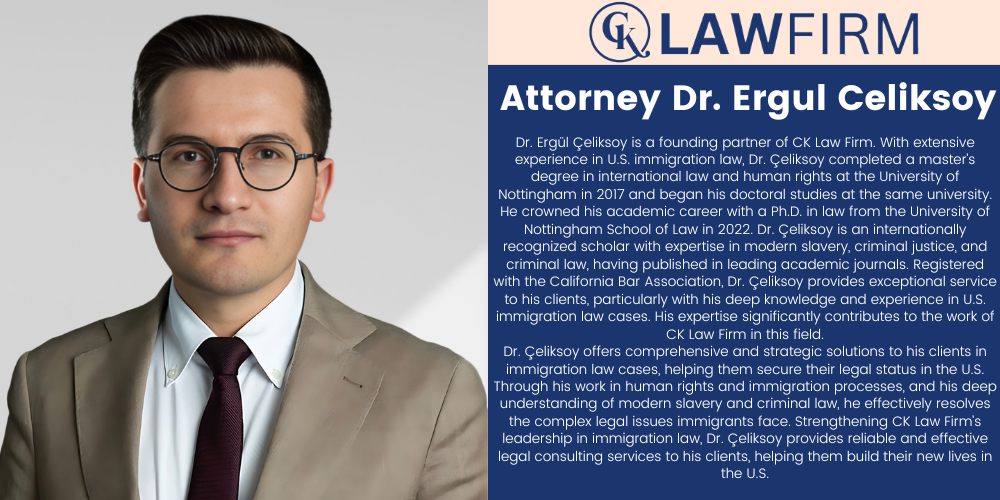
By Asim Kilinc, Immigration Attorney at CK Law Firm
Becoming a U.S. citizen is a significant milestone for many immigrants. The process, however, can be complex and time-consuming. As an immigration attorney, I have guided many clients through this journey. In this detailed guide, I will provide step-by-step instructions for applying for U.S. citizenship, including preparation tips for the citizenship test.
Step 1: Determine Your Eligibility
Before applying for U.S. citizenship, you must ensure that you meet the eligibility criteria:
- Age: You must be at least 18 years old.
- Permanent Resident Status: You must have been a lawful permanent resident (Green Card holder) for at least 5 years, or 3 years if you are married to a U.S. citizen.
- Physical Presence: You must have been physically present in the U.S. for at least 30 months out of the last 5 years, or 18 months out of the last 3 years if married to a U.S. citizen.
- Continuous Residence: You must have lived in the U.S. continuously for the specified period.
- Good Moral Character: You must demonstrate good moral character, which generally means having no serious criminal record.
- English and Civics Knowledge: You must have a basic understanding of English and U.S. government and history.
Step 2: Complete Form N-400
The next step is to complete Form N-400, Application for Naturalization. Here’s how:
- Download Form N-400: Visit the USCIS website to download the form and instructions.
- Fill Out the Form: Provide accurate and complete information. Common sections include personal information, residence and employment history, travel history, and criminal background.
- Sign and Date: Ensure that you sign and date the form before submission.
Example: I once had a client, John, who was unsure about how to fill out the travel history section. We carefully reviewed his travel dates to ensure accuracy, avoiding potential delays.
Step 3: Gather Supporting Documents
Along with Form N-400, you will need to submit several supporting documents:
- Photocopy of Your Green Card: Both sides.
- Proof of Marriage: If applying based on marriage to a U.S. citizen.
- Proof of Termination of Prior Marriages: If applicable.
- Two Passport-Style Photos: If residing outside the U.S.
- Additional Documents: Depending on your specific situation, such as evidence of military service or tax records.
Step 4: Submit Your Application
Submit your completed Form N-400, supporting documents, and the application fee to USCIS. You can file online or by mail. The current fee is $725, which includes the $640 application fee and the $85 biometric services fee.
Example: Sarah, another client, opted to file her application online, which streamlined the process and allowed her to track the status of her application easily.
Step 5: Attend the Biometrics Appointment
After submitting your application, you will receive a notice for a biometrics appointment. During this appointment, USCIS will take your fingerprints, photograph, and signature for background checks.
- Prepare for the Appointment: Bring your appointment notice, Green Card, and another form of ID (e.g., passport or driver’s license).
- Appointment Day: Arrive early and follow the instructions provided by the USCIS officer.
Step 6: Prepare for the Citizenship Interview and Test
The citizenship interview and test are crucial components of the naturalization process. Here’s how to prepare:
1. Study for the Civics Test
- Study Materials: Use the official USCIS study materials.
- Topics: U.S. history, government, symbols, and holidays.
- Practice Tests: Take practice tests to gauge your readiness.
2. Improve Your English Skills
- Reading and Writing: Practice reading and writing simple sentences in English.
- Speaking and Listening: Engage in conversations with English speakers to improve your listening and speaking skills.
Example: David, a client who struggled with English, enrolled in ESL (English as a Second Language) classes and used USCIS flashcards to study for the civics test. This preparation helped him pass both the language and civics tests confidently.
Step 7: Attend Your Citizenship Interview
You will receive an appointment notice for your citizenship interview. Here’s what to expect and how to prepare:
- Review Your Application: Familiarize yourself with the information you provided in Form N-400.
- Bring Required Documents: Appointment notice, Green Card, passport, state ID, and any additional documents requested by USCIS.
- Interview Day: Dress professionally, arrive early, and be polite and honest during the interview.
Common Questions: The USCIS officer will ask questions about your application, background, and your understanding of U.S. civics. They will also assess your English proficiency.
Step 8: Receive a Decision
After your interview, USCIS will notify you of their decision:
- Granted: If approved, you will receive a notice for the Oath of Allegiance ceremony.
- Continued: If additional information is needed, USCIS will provide instructions.
- Denied: If denied, USCIS will provide reasons and information on how to appeal.
Step 9: Attend the Oath of Allegiance Ceremony
If your application is approved, you will be scheduled for an Oath of Allegiance ceremony. This is the final step in the naturalization process:
- What to Bring: Your appointment notice, Green Card, and any other required documents.
- Ceremony Day: You will take the Oath of Allegiance, receive your Certificate of Naturalization, and officially become a U.S. citizen.
Example: Maria, a client from Mexico, described her Oath of Allegiance ceremony as one of the proudest moments of her life. She was joined by her family and friends, making it a memorable celebration.
Conclusion
Applying for U.S. citizenship is a significant and rewarding journey. By following these step-by-step instructions and preparing thoroughly for each stage, you can navigate the process with confidence. At CK Law Firm, we are committed to supporting you every step of the way. Contact us today for expert legal advice and personalized assistance.
By Ergul Celiksoy, Immigration Attorney at CK Law Firm
The United States offers a variety of work visas for individuals seeking employment opportunities. Navigating these options can be complex due to the different requirements, application processes, and benefits associated with each visa type. This comprehensive guide will explore the most common work visas available in the U.S., including the H-1B, L-1, and O-1 visas, providing detailed information to help you determine the best option for your specific situation.
H-1B Visa: Specialty Occupations
Overview The H-1B visa is designed for foreign workers in specialty occupations that require theoretical or technical expertise in fields such as IT, engineering, mathematics, science, and medicine.
Eligibility Requirements
- Job Offer: Must have a job offer from a U.S. employer for a specialty occupation.
- Educational Qualifications: Must hold a bachelor’s degree or higher in the specific specialty, or its equivalent.
- Employer Sponsorship: The U.S. employer must sponsor the visa and demonstrate that they are paying the prevailing wage for the position.
Application Process
- Labor Condition Application (LCA): The employer must file an LCA with the Department of Labor (DOL).
- Form I-129: The employer files Form I-129, Petition for a Non-immigrant Worker, with USCIS.
- USCIS Decision: USCIS reviews the petition and makes a decision. If approved, the applicant can apply for an H-1B visa at a U.S. consulate or embassy.
Validity and Extensions
- Initial Period: Up to three years.
- Extensions: Can be extended for up to six years, with some exceptions for longer durations under certain circumstances.
Example: John, an IT professional, received an H-1B visa sponsored by a leading tech company. His employer filed the LCA and Form I-129, and after USCIS approval, John obtained his visa and started working in the U.S.
L-1 Visa: Intra-Company Transferees
Overview The L-1 visa is for employees of international companies who are being transferred to a parent, branch, affiliate, or subsidiary of the same company in the U.S. It is divided into two categories: L-1A for managers and executives, and L-1B for employees with specialized knowledge.
Eligibility Requirements
- Employment: Must have been employed by the foreign company for at least one continuous year within the three years preceding the application.
- Position: Must be transferring to a managerial, executive, or specialized knowledge position in the U.S.
Application Process
- Form I-129: The U.S. employer files Form I-129, Petition for a Non-immigrant Worker, with USCIS.
- Supporting Documents: Include proof of the qualifying relationship between the U.S. and foreign entities and evidence of the applicant’s employment and qualifications.
Validity and Extensions
- L-1A Visa: Valid for up to three years, with extensions available for a maximum of seven years.
- L-1B Visa: Valid for up to three years, with extensions available for a maximum of five years.
Example: Maria, an executive at a multinational corporation, was transferred to the company’s U.S. branch on an L-1A visa. The company filed Form I-129 along with supporting documents, and after USCIS approval, Maria began her role in the U.S.
O-1 Visa: Individuals with Extraordinary Ability or Achievement
Overview The O-1 visa is for individuals with extraordinary ability in sciences, arts, education, business, athletics, or extraordinary achievement in the motion picture and television industry.
Eligibility Requirements
- Extraordinary Ability: Demonstrated by sustained national or international acclaim and recognized achievements.
- Evidence: Must provide extensive documentation of their extraordinary ability, such as awards, publications, and high salary.
Application Process
- Form I-129: The employer or agent files Form I-129, Petition for a Non-immigrant Worker, with USCIS.
- Consultation: A written advisory opinion from a peer group, labor organization, or management organization in the applicant’s field of expertise.
- Supporting Documents: Include evidence of extraordinary ability and the job offer or itinerary in the U.S.
Validity and Extensions
- Initial Period: Up to three years.
- Extensions: Can be extended in one-year increments based on the time required to complete the initial event or activity.
Example: Ahmed, a world-renowned scientist, was offered a research position at a prestigious U.S. university. The university filed Form I-129, along with extensive evidence of Ahmed’s achievements and a peer advisory opinion. After USCIS approval, Ahmed obtained his O-1 visa and began his research in the U.S.
Additional Work Visa Options
1. E-1/E-2 Visa: Treaty Traders and Investors
- E-1 Visa: For individuals engaged in substantial trade between the U.S. and their treaty country.
- E-2 Visa: For individuals investing a substantial amount of capital in a U.S. business.
2. TN Visa: NAFTA Professionals
- Available to Canadian and Mexican citizens in certain professional occupations as specified under the North American Free Trade Agreement (NAFTA).
3. H-2A/H-2B Visa: Temporary Agricultural and Non-Agricultural Workers
- H-2A Visa: For temporary agricultural workers.
- H-2B Visa: For temporary non-agricultural workers in seasonal or peak-load positions.
Conclusion
Exploring the various work visa options in the U.S. can open doors to numerous professional opportunities. Understanding the requirements and application processes for each visa type is crucial for a successful application. At CK Law Firm, we are dedicated to providing expert legal support tailored to your unique situation. Contact us today to discuss your immigration needs and explore how we can help you achieve your professional goals in the United States.
By Ergul Celiksoy, Immigration Attorney at CK Law Firm
Studying in the United States is an important step for many international students to achieve their career goals and access broader opportunities. Particularly, gaining practical experience in their field of study after completing their education in the U.S. is extremely valuable for those planning to live in the U.S. permanently. At this point, the OPT (Optional Practical Training) program serves as a bridge, offering students a significant opportunity to take a step towards obtaining a Green Card. In this article, I will provide detailed information on what OPT is, how to apply, its duration, STEM OPT extension, job change rules, and its relation to the Green Card process.
- What is OPT?
- Types of OPT
- Duration of the OPT Program
- Eligibility Requirements for OPT
- OPT Application Process
- STEM OPT Extension
- Rules for Changing Jobs on OPT
- OPT and H-1B Visa
- Green Card Application Process
- Connection Between OPT and Green Card
- What Happens When OPT Expires?
If you have any questions beyond those listed above, feel free to reach out to me via the comment section of this article, through LinkedIn messages, or directly via the website of CK Law Firm, where I am a co-founder.
What is OPT?
Optional Practical Training (OPT) is a work authorization program that allows international students studying in the U.S. on an F-1 visa to gain practical experience by working in a job related to their field of study, either before or after graduation. The OPT program supports students’ academic careers and helps them gain a competitive advantage in the U.S. job market.
The OPT program stands out as a strategic opportunity, especially for students aiming to stay longer in the U.S. and pave the way for applying for a Green Card.
Types of OPT
Optional Practical Training can be categorized into two main types, allowing students to obtain work authorization either before or after graduation:
- Pre-completion OPT: Students may request part-time work authorization (up to 20 hours per week) while continuing their studies. During school breaks, this can be extended to full-time. Pre-completion OPT is particularly beneficial for students looking to gain hands-on experience through summer internships or other temporary jobs related to their studies.
- Post-completion OPT: After completing their education, students can work full-time for one year in their field of study. This phase allows students to begin their professional careers and later apply for an H-1B visa and Green Card. Post-completion OPT serves as a critical starting point for a student’s career.
Duration of the OPT Program
The Optional Practical Training program is generally valid for 12 months after graduation. However, students in STEM (Science, Technology, Engineering, and Mathematics) fields can extend this period. STEM graduates may extend their OPT for an additional 24 months, bringing the total duration to 36 months.
Eligibility Requirements for OPT
To apply for OPT, students must meet certain eligibility criteria:
- F-1 Visa: Students applying for OPT must hold a valid F-1 student visa throughout their education in the U.S.
- Full-time Student Status: At the time of application, students must be enrolled as full-time students in their program of study.
- Related Field of Study: The job students work in under OPT must be directly related to their field of study. For instance, an engineering student must work in a related engineering job and cannot work in a job unrelated to their field of study.
- Form I-765: OPT applications are submitted by completing the Form I-765 provided by U.S. Citizenship and Immigration Services (USCIS).
OPT Application Process
Applying for OPT is a crucial step for students completing their education in the U.S. The process generally involves the following steps:
- Timing of Application: Students applying for post-completion OPT can start the process up to 90 days before their graduation date. The approval process, depending on the volume of applications, can take 3-5 months. Therefore, timely submission of applications is critical.
- USCIS Approval: Once the application is reviewed and approved by USCIS, the student will receive work authorization. It is important for students to ensure all documents are complete during this process.
- Employment Authorization Document (EAD): Once approved, students will receive an EAD card, which indicates their legal right to work under OPT.
- Job Search Process: Students must find a job related to their field of study during their OPT period. If a student is unable to secure a job, the unemployment period is limited to 90 days. If a student does not find a job within this time, their work authorization may be revoked.
STEM OPT Extension
Students graduating from STEM fields are eligible for an additional 24-month extension after their initial 12-month OPT period. This extension gives STEM graduates a total of 36 months to stay in the U.S. and prepare for applying for a Green Card.
To qualify for the STEM OPT extension, the student’s employer must be enrolled in the E-Verify system, a government program that verifies the employment eligibility of workers. The job must be related to the student’s field of study, and the employer must be registered in E-Verify.
Rules for Changing Jobs on OPT
Students working under OPT can switch to different jobs as long as they are in a field related to their studies. However, any job changes must be reported to USCIS. Students must not remain unemployed for more than a total of 90 days. When changing jobs, students should ensure that the position is still relevant to their field of study and meets the requirements of the OPT program.
OPT and H-1B Visa
OPT can be seen as a stepping stone towards obtaining an H-1B visa for students planning to work in the U.S. permanently. The H-1B visa is a work visa granted to foreign nationals in specialized occupations. If a student finds an employer during their OPT period who sponsors them for an H-1B visa, they can continue working in the U.S. and begin the Green Card application process.
Green Card Application Process
OPT is a critical step for students aiming to apply for a Green Card. If an employer sponsors an H-1B application and the student stays in the U.S. for a longer period, they can initiate the Green Card application process. Through employer sponsorship, a student can obtain permanent residency in the U.S.
Connection Between OPT and Green Card
OPT, particularly for students in STEM fields, plays a crucial role in the path towards obtaining a Green Card. With the STEM OPT extension, students can work in the U.S. for up to 36 months, increasing their chances of obtaining employer sponsorship for a Green Card. Students who gain work experience in the U.S. job market during OPT are more likely to secure an H-1B visa, paving the way for long-term residency.
What Happens When OPT Expires?
When OPT expires, students typically apply for an H-1B visa. The H-1B visa is sponsored by an employer and allows individuals to continue working in their specialized field. With the H-1B visa, individuals can apply for a Green Card and secure permanent residency. If an H-1B application is not submitted during the OPT period, and the student is not in a STEM field, they may risk losing their legal status in the U.S.
In conclusion, Optional Practical Training not only offers international students the opportunity to gain practical experience in their field of study but also serves as a crucial first step towards obtaining permanent residency in the U.S. For STEM graduates, the additional extension provides a significant advantage for those looking to apply for a Green Card.
Proper management of the OPT application process and collaboration with USCIS is essential. At CK Law Firm, we are here to support you at every stage, from OPT applications to the Green Card process. For more information and consultation services, feel free to reach out to us via cklawfirm.org, email us at info@cklawfirm.org, or contact us through LinkedIn.
Who is Attorney Ergül Çeliksoy?
Attorney Dr. Ergül Çeliksoy is a founding partner of CK Law Firm and also serves as an Assistant Professor of Law at the University of Nottingham. With extensive experience in U.S. immigration law, Dr. Çeliksoy completed a Master’s degree in international law and human rights law at the University of Nottingham in 2017, followed by a Ph.D. at the same university. His Ph.D., completed in 2022 at the University of Nottingham School of Law, marked a significant milestone in his academic career. Dr. Çeliksoy has published extensively in leading academic journals and is internationally recognized for his expertise in modern slavery, criminal justice, and criminal law. As a member of the California Bar, Dr. Çeliksoy offers exceptional service to his clients, particularly in U.S. immigration law cases. His expertise and experience in immigration law significantly contribute to CK Law Firm’s work in this area.
Dr. Çeliksoy provides comprehensive and strategic solutions to his clients in immigration law cases, helping secure their legal status in the U.S. His work on human rights and immigration processes, particularly in modern slavery and criminal law, effectively addresses the complex legal issues immigrants face. Dr. Çeliksoy reinforces CK Law Firm’s leadership in immigration law by offering reliable and effective legal consulting services to his clients, helping them build new lives in the United States.
Subscribe to Our Newsletter
Subscribe to our newsletter to stay informed about the latest announcements and articles written by our attorneys on U.S. immigration processes.
Sobre Nosotros
Contáctanos
+1 (945) 527- 23 22
Correo electrónico
info@cklawfirm.org
Dirección
2800 Regal Rd #102, Plano, TX 75075

All Rights Reserved by CK Law Firm.


